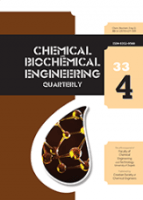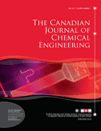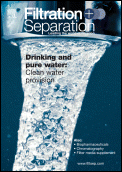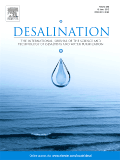
Journal of Membrane Science Letters
Scope & Guideline
Elevating Knowledge in Membrane Systems
Introduction
Aims and Scopes
- Membrane Material Development:
Research aimed at the synthesis and characterization of new membrane materials, including polymers, composites, and nanomaterials, that exhibit enhanced separation properties. - Membrane Performance Optimization:
Studies focusing on improving membrane efficiency through engineering approaches, such as modifying surface properties, pore structure, or using additives to mitigate fouling. - Separation Processes:
Exploration of various membrane-based separation processes including desalination, gas separation, and wastewater treatment, aimed at addressing environmental challenges. - Characterization Techniques:
Development and application of advanced characterization methods for membranes to understand their structure-function relationships and performance metrics. - Sustainability and Recycling:
Investigations into the sustainability aspects of membrane technology, including recycling of membranes and the use of green solvents and processes.
Trending and Emerging
- Advanced Functional Membranes:
There is a growing trend towards the development of membranes with tailored functionalities, such as charge-patterning and bio-inspired designs, aimed at enhancing separation performance and fouling resistance. - Nanomaterials and Hybrid Membranes:
The incorporation of nanomaterials, such as metal-organic frameworks (MOFs) and graphene, into membrane structures is increasingly prominent, providing significant improvements in selectivity and permeability. - Sustainable and Green Chemistry Approaches:
Research is increasingly focusing on sustainable practices in membrane fabrication, including the use of biosourced materials and environmentally friendly solvents, aligning with global sustainability goals. - Data-Driven and Machine Learning Approaches:
The application of machine learning techniques to optimize membrane design and performance evaluation is emerging as a significant trend, promising to enhance predictive capabilities and innovation in membrane research. - Membranes for Energy Applications:
There is a noticeable increase in research addressing the use of membranes in energy-related applications, such as carbon capture and hydrogen production, reflecting the urgent need for solutions to climate change.
Declining or Waning
- Traditional Membrane Fouling Studies:
Research on conventional fouling mechanisms and mitigation strategies appears to be declining, potentially due to the emergence of more advanced antifouling materials and techniques that are gaining traction. - Basic Theoretical Models:
The emphasis on fundamental theoretical models for membrane processes has waned, as researchers increasingly focus on practical applications and experimental validations rather than solely theoretical developments. - Single-Use Membrane Applications:
There is a diminishing focus on single-use membrane technologies, which may be replaced by more sustainable, reusable solutions in line with increasing environmental awareness.
Similar Journals

Biochemistry Moscow Supplement Series A-Membrane and Cell Biology
Navigating the Evolving Landscape of BiochemistryBiochemistry Moscow Supplement Series A-Membrane and Cell Biology, published by PLEIADES PUBLISHING INC in the United States, is a pivotal journal in the fields of biochemistry, biophysics, and cell biology. Established in 2008, this journal has become a significant platform for disseminating novel research findings and reviews, fostering advanced studies in membrane dynamics and cellular processes. Although currently ranked in the Q4 quartile across its categories, the journal provides researchers and professionals with open access to a wealth of knowledge, helping to bridge gaps in understanding complex biochemical mechanisms. The journal’s commitment to quality and relevance is evident as it continues to contribute to the academic community through its coverage of innovative and emerging topics in cell and membrane biology. Researchers, practitioners, and students alike will find this resource invaluable for keeping abreast of the latest developments in the ever-evolving landscape of biochemistry and cellular research.

Membrane and Water Treatment
Exploring Advanced Membrane Technologies for Clean WaterMembrane and Water Treatment is a prominent academic journal published by TECHNO-PRESS, dedicated to the fields of chemical engineering and water science. With an ISSN of 2005-8624 and E-ISSN 2092-7037, this journal aims to disseminate innovative research and technological advancements related to membrane technologies and water treatment processes. Since its inception in 2010, it has steadily contributed to the body of knowledge, achieving a Q3 ranking in Chemical Engineering and a Q4 ranking in Water Science and Technology as of 2023. Positioned within the 35th percentile of its respective categories in Scopus, it serves as a critically accessed platform for researchers and professionals eager to explore cutting-edge methodologies and solutions to water management challenges. Based in South Korea, Membrane and Water Treatment is committed to providing a scholarly environment where interdisciplinary and collaborative research can flourish, ensuring that readers remain at the forefront of developments in this essential field.

CHEMICAL AND BIOCHEMICAL ENGINEERING QUARTERLY
Exploring the Frontiers of Chemical and Biochemical ResearchCHEMICAL AND BIOCHEMICAL ENGINEERING QUARTERLY, published by the Croatian Society of Chemical Engineering Technology, is a distinguished open-access journal that has been providing a platform for the dissemination of innovative research since its inception in 1987. With a focus on the fields of biochemistry and chemical engineering, this quarterly journal addresses a wide array of topics, including process chemistry and technology, making significant contributions to both academia and industry. Despite its current positioning in the Q4 category for biochemistry and Q3 for miscellaneous chemistry and process chemistry in 2023, the journal continues to strive for greater impact, catering to researchers, professionals, and students alike. Its open-access model, in place since 2001, ensures that cutting-edge research is accessible to a broad audience, fostering collaboration and knowledge sharing within the scientific community. By promoting high-quality research and providing insights into the latest advancements, Chemical and Biochemical Engineering Quarterly remains an essential resource for those involved in the chemical and biochemical engineering disciplines.

Water Reuse
Transforming Water Futures, One Drop at a Time.Water Reuse is a pioneering journal dedicated to advancing the field of water science and technology, particularly focusing on innovations in water recycling and reuse strategies. Published by IWA Publishing in the United Kingdom, this journal has quickly established itself as a vital resource for researchers, professionals, and students engaged in sustainable water management practices. With an impressive impact factor and a ranking that places it in the top quartile for both Water Science and Technology and Filtration and Separation, Water Reuse offers an open-access platform that fosters the dissemination of high-quality research. Since its inception in 2021, it has garnered attention for its commitment to addressing critical global challenges related to water scarcity and environmental sustainability. The journal provides a crucial forum for the exchange of knowledge and best practices, contributing significantly to the advancement of water reuse methodologies. By encouraging interdisciplinary collaboration and the publication of pioneering studies, Water Reuse is poised to play a central role in shaping the future of water management.

JOURNAL OF MEMBRANE BIOLOGY
Unveiling the Secrets of Biological MembranesWelcome to the Journal of Membrane Biology, a premier publication dedicated to advancing our understanding of the complex roles membranes play in biological systems. Published by Springer, this journal features research articles, reviews, and communications on a broad range of topics related to membrane biology, including biomolecular interactions, transport mechanisms, and physiological responses. With an ISSN of 0022-2631 and E-ISSN 1432-1424, the journal has been a cornerstone in the field since its inception in 1969 and continues to thrive as it looks towards 2024. Ranked in the second quartile (Q2) for Biophysics and Physiology, and third quartile (Q3) in Cell Biology, it showcases impactful research that embodies the spirit of scientific inquiry and innovation. Although currently not an Open Access journal, it remains easily accessible to researchers, professionals, and students eager to delve into the dynamic world of membrane studies. As the understanding of membrane dynamics expands, so does its relevance in areas such as drug development and cellular engineering, making the Journal of Membrane Biology an essential resource for those at the forefront of these critical scientific advancements.

Membranes
Connecting researchers to the forefront of membrane technology.Membranes, published by MDPI since 2011, is an esteemed open access journal dedicated to advancing the field of membrane science and technology. With an E-ISSN of 2077-0375, this journal serves as a vital platform for researchers and professionals from various disciplines such as chemical engineering, filtration, and separation technologies. Holding a commendable Q2 ranking in Chemical Engineering (miscellaneous) and notable placement in filtration and process chemistry categories, it provides a robust framework for researchers to disseminate groundbreaking findings. The journal's commitment to open access ensures a wide-reaching impact, allowing for unrestricted sharing of high-quality research that addresses the critical challenges and innovations in membrane technology. Situated in Switzerland, Membranes is not only a cornerstone for academic inquiry but also a leading resource for students and industry experts seeking cutting-edge developments in their fields.

CANADIAN JOURNAL OF CHEMICAL ENGINEERING
Cultivating Excellence in Chemical Engineering ScholarshipCanadian Journal of Chemical Engineering, published by Wiley, stands as a pivotal platform in the field of chemical engineering, addressing a myriad of topics essential for researchers, professionals, and students alike. With ISSN 0008-4034 and E-ISSN 1939-019X, this journal has been a cornerstone of chemical engineering scholarship since its inception in 1958 and continues to provide valuable insights through its rigorous peer-reviewed articles. The journal is ranked in the Q2 category of the Scopus quartile rankings, reflecting its influence and relevance within the chemical engineering community, with a notable position of #137 out of 273 in the general chemical engineering field. Although it does not offer open access options, its comprehensive coverage of contemporary research and applications solidifies its status as a vital resource for advancing knowledge and innovation in chemical engineering.

Filtration + Separation
Exploring Cutting-Edge Technologies in Separation ProcessesFiltration + Separation is a distinguished journal published by MA HEALTHCARE LTD, specializing in the fields of filtration technology, separation processes, and their applications within environmental science and industrial engineering. With a commitment to advancing knowledge in these critical areas, this journal, established in 1970, has consistently provided a platform for innovative research and developments, catering to the unique challenges of the filtration and separation industry. Despite its recent categorization in the Q4 quartile across various fields, including Environmental Science and Industrial Engineering, it remains pivotal for researchers and professionals seeking to stay abreast of emerging trends and technologies. The journal is accessible through traditional subscription models and aims to bridge the gap between academic research and practical applications. As the industry evolves, Filtration + Separation continues to serve as an invaluable resource for both seasoned experts and budding scholars passionate about enhancing separation processes and environmental sustainability.

DESALINATION
Elevating the discourse on desalination and water sustainability.DESALINATION, a leading journal in the field of water science and technology, is published by Elsevier and has been a pivotal resource since its inception in 1966. With its commitment to advancing the disciplines of chemical engineering, materials science, and mechanical engineering, this journal boasts an impressive impact factor, reflecting its esteemed position in category quartiles, as it ranks in the Q1 tier across various fields including Water Science and Technology and Chemical Engineering. Researchers rely on DESALINATION for its cutting-edge studies and comprehensive reviews that address critical challenges in desalination methods and water treatment technologies. Operating in a non-open access format, the journal ensures high-quality peer-reviewed articles are readily accessible to professionals and academics seeking to enhance their understanding of water resources and sustainable practices. Its Scopus rankings place it among the top 10% in multiple applicable domains, making it an essential archive for ongoing research and innovative solutions aimed at addressing global water scarcity.

SEPARATION AND PURIFICATION TECHNOLOGY
Pioneering research in separation and purification technologies.SEPARATION AND PURIFICATION TECHNOLOGY is a leading multidisciplinary journal published by Elsevier, focused on advancing the fields of Analytical Chemistry and Filtration and Separation. With its ISSN 1383-5866 and E-ISSN 1873-3794, this prestigious journal has achieved remarkable recognition, ranking in the top quartile (Q1) in both its categories, reflecting its substantial impact and relevance in the scientific community. Operating from its headquarters in Amsterdam, Netherlands, SEPARATION AND PURIFICATION TECHNOLOGY serves as a vital platform for researchers, professionals, and students to disseminate innovative findings and methodologies related to separation processes and purification techniques. The journal not only promotes open access research but also maintains a rigorous peer-review process to ensure high-quality publications. With a convergence period spanning from 1997 to 2025, it highlights the ongoing evolution and importance of separation technology in various applications, establishing it as an essential resource for those interested in cutting-edge advancements in analytical and chemical engineering domains.